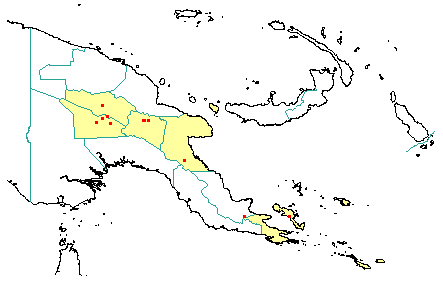
in PNGplants database
PNGTreesKey – Casearia pachyphylla Gilg |
Barry Conn (NSW) & Kipiro Damas (LAE).
Guide to trees of Papua New Guinea
Copyright held by the authors, National Herbarium of New South Wales, and Papua New Guinea National Herbarium
Botanische Jahrbucher für Systematik, Pflanzengeschichte und Pflanzengeographie Vol. 55: 288 (1918) Fig. 8.
Other Literature: H. Sleumer, Flora Malesiana, Series 1, 87-88 (1954)
Family: Salicaceae
Dicotyledon
Timber Group: Non-timber species
Field Characters: Small sub-canopy tree; Bole cylindrical; straight; buttresses buttresses absent; spines spines absent; aerial roots aerial roots absent; stilt roots stilt roots absent; Bark grey, rough, fissured or furrowed cork; Subrhytidome (under-bark) green; less than 25 mm thick; bark blaze consisting of one layer; faintly to non-aromatic; outer blaze pale yellow, markings absent; inner blaze pale yellow, markings absent; terminal buds not enclosed by leaves.
Indumentum: Complex hairs absent; stinging hairs absent; mature twig indumentum (hairs) present, hairs dense (fulvous).
Leaves: Leaves spaced along branches, spiral (leaves occurring singly at a node and arranged spirally up the branchlet), simple (a leaf composed of a single blade); petiole present, not winged, attached to base of leaf blade, not swollen; leaves broadest at or near middle or broadest below middle, (4.0-) 7.0-12.0 cm, (2.0-) 2.5-5.0 cm; symmetric, entire, not dissected or lobed, obtuse or acuminate, venation pinnate, secondary veins open, prominent, intramarginal veins absent; leaves lower surface dull pale green or red when young, upper surface dark green (glossy), indumentum (hairs) present, indumentum (hairs) dense to sparse; present; domatia absent; stipules present, free, laterally placed, not encircling the twig, scale-like to leafy, not fringed, small, not persistent.
Flowers: Inflorescence axillary, flowers arising from a single point (on end of peduncle), cones absent; flowers bisexual, stalked, flowers with many planes of symmetry, 2.5-3.0 mm long, diameter small (up to10 mm diam.); perianth present, with all sepals and/or petals (hence tepals) similar to petals absent, inner perianth slightly green or cream-coloured (sepals); 5, free or some or partly joined (shortly joined); stamens 10, present, joined, free of the perianth; ovary superior, carpels joined (when more than one), locules 3; styles absent or solitary (short), 0-1.
Fruits: Infrutescence arising from single point, fruit 15.0-20.0 mm long, yellow or orange, not spiny, slightly fleshy, simple, dehiscent, capsule; seeds many 100, not winged, narrow (longer than wide).
Distribution: Morobe, Western Highlands, Eastern Highlands, Southern Highlands, Milne Bay & Papuan Islands.
 | Botanical records in PNGplants database |
Notes: Notes This genus was previously classified in the family Flacourtiaceae.